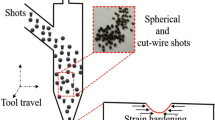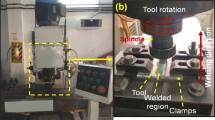Abstract
With the increasing usage of Al alloys in vehicle manufacture, it is necessary to join dissimilar Al alloys with lap joint. However, hot cracking is a challenging issue due to the chemical composition and thermal tension, which greatly determines the reliability of automobile operation. Among different Al alloys, the series 5000 (Al–Mg) and 6000 (Al–Mg–Si) are widely used. To better understand the hot cracking behavior, various stack ups of AA5754 and AA6013 were laser welded to investigate the effects of process parameters on hot cracking formation. The chemical composition, microstructure, fusion ratio, and fracture morphology of the weld joint were also examined. The results showed that the order of material stacking affected weld’s susceptibility to hot cracking significantly, and the critical process parameters were obtained for tested conditions which could effectively reduce hot cracking. The findings from this work provide guidance for hot cracking prevention in laser welding of dissimilar Al alloys.

















Similar content being viewed by others
References
M. Schoenitz and E.L. Dreizin: Structure and properties of Al–Mg mechanical alloys. J. Mater. Res. 18, 1827 (2003).
X. Liu, S. Lan, and J. Ni: Analysis of process parameters effects on friction stir welding of dissimilar aluminum alloy to advanced high strength steel. Mater. Des. 59, 50 (2014).
A. Heinz, A. Haszler, C. Keidel, S. Moldenhauer, R. Benedictus, and W. Miller: Recent development in aluminium alloys for aerospace applications. Mater. Sci. Eng., A 280, 102 (2000).
D. Živković and B. Anzulović: The fatigue of 5083 aluminium alloy welds with the shot-peened crater hot-cracks. Mater. Des. 26, 247 (2005).
W. Miller, L. Zhuang, J. Bottema, A.J. Wittebrood, P. De Smet, A. Haszler, and A. Vieregge: Recent development in aluminium alloys for the automotive industry. Mater. Sci. Eng., A 280, 37 (2000).
K.R. Brown, M.S. Venie, and R.A. Woods: The increasing use of aluminum in automotive applications. JOM 47, 20 (1995).
T. Sakayama, Y. Naito, Y. Miyazakki, T. Nose, G. Murayma, K. Saita, and H. Oikawa: Dissimilar metal joining technologies for steel sheet and aluminum alloy sheet in auto body. Nippon Steel Technical Report 103, 91 (2013).
A. Kumar and S. Sundarrajan: Optimization of pulsed TIG welding process parameters on mechanical properties of AA 5456 aluminum alloy weldments. Mater. Des. 30, 1288 (2009).
Y. Zhang and S. Zhang: Welding aluminum alloy 6061 with the opposing dual-torch GTAW process. Weld. J. 78, 222-s (1999).
T. Senthil Kumar, V. Balasubramanian, and M. Sanavullah: Influences of pulsed current tungsten inert gas welding parameters on the tensile properties of AA 6061 aluminium alloy. Mater. Des. 28, 2080 (2007).
Y. Zhang, C. Pan, and A. Male: Improved microstructure and properties of 6061 aluminum alloy weldments using a double-sided arc welding process. Metall. Mater. Trans. A 31, 2537 (2000).
W. Thomas and E. Nicholas: Friction stir welding for the transportation industries. Mater. Des. 18, 269 (1997).
V. Fahimpour, S. Sadrnezhaad, and F. Karimzadeh: Corrosion behavior of aluminum 6061 alloy joined by friction stir welding and gas tungsten arc welding methods. Mater. Des. 39, 329 (2012).
E. Taban, J.E. Gould, and J.C. Lippold: Dissimilar friction welding of 6061-T6 aluminum and AISI 1018 steel: Properties and microstructural characterization. Mater. Des. 31, 2305 (2010).
J.M. Sánchez-Amaya, T. Delgado, L. González-Rovira, and F.J. Botana: Laser welding of aluminium alloys 5083 and 6082 under conduction regime. Appl. Surf. Sci. 255, 9512 (2009).
P. Okon, G. Dearden, K. Watkins, M. Sharp, and P. French: Laser welding of aluminium alloy 5083. In ICALEO, 1 (2002).
L. Quintino, A. Costa, R. Miranda, D. Yapp, V. Kumar, and C. Kong: Welding with high power fiber lasers–a preliminary study. Mater. Des. 28, 1231 (2007).
J. Jia, S-L. Yang, W-Y. Ni, and J-Y. Bai: Microstructure and mechanical properties of fiber laser welded joints of ultrahigh-strength steel 22MnB5 and dual-phase steels. J. Mater. Res. 29, 2565 (2014).
A. Haboudou, P. Peyre, A.B. Vannes, and G. Peix: Reduction of porosity content generated during Nd:YAG laser welding of A356 and AA5083 aluminium alloys. Mater. Sci. Eng., A 363, 40 (2003).
Y. Chino, H. Iwasaki, and M. Mabuchi: Cavity growth rate in superplastic 5083 Al and AZ31 Mg alloys. J. Mater. Res. 19, 3382 (2004).
K. Behler, J. Berkmanns, A. Ehrhardt, and W. Frohn: Laser beam welding of low weight materials and structures. Mater. Des. 18, 261 (1997).
A. El-Batahgy and M. Kutsuna: Laser beam welding of AA5052, AA5083, and AA6061 aluminum alloys. Adv. Mater. Sci. Eng. 2009, 1 (2009).
R. Akhter, L. Ivanchev, and H.P. Burger: Effect of pre/post T6 heat treatment on the mechanical properties of laser welded SSM cast A356 aluminium alloy. Mater. Sci. Eng., A 447, 192 (2007).
T.Y. Kuo and H.C. Lin: Effects of pulse level of Nd-YAG laser on tensile properties and formability of laser weldments in automotive aluminum alloys. Mater. Sci. Eng., A 416, 281 (2006).
A.S. Nagelberg: Observations on the role of Mg and Si in the directed oxidation of Al–Mg–Si alloys. J. Mater. Res. 7, 265 (1992).
T. Luijendijk: Welding of dissimilar aluminium alloys. J. Mater. Process. Technol. 103, 29 (2000).
S. Katayama, Y. Kawahito, and M. Mizutani: Elucidation of laser welding phenomena and factors affecting weld penetration and welding defects. Phys. Procedia 5, 9 (2010).
E. Cicală, G. Duffet, H. Andrzejewski, D. Grevey, and S. Ignat: Hot cracking in Al–Mg–Si alloy laser welding—Operating parameters and their effects. Mater. Sci. Eng., A 395, 1 (2005).
S. Kou: Solidification and liquation cracking issues in welding. JOM 55, 37 (2003).
G. Cao and S. Kou: Predicting and reducing liquation-cracking susceptibility based on temperature vs. fraction solid. Weld. J. 85, 9-s (2006).
B. Andersson and L. Karlsson: Thermal stresses in large butt-welded plates. J. Therm. Stresses 4, 491 (1981).
L. Hernandez and T. North: The influence of external local heating in preventing cracking during welding of aluminum alloy sheet. Weld. J. 63, 84-s (1984).
H. Ahmed, M. Wells, D. Maijer, B. Howes, and M. van der Winden: Modelling of microstructure evolution during hot rolling of AA5083 using an internal state variable approach integrated into an FE model. Mater. Sci. Eng., A 390, 278 (2005).
G. Cao and S. Kou: Liquation cracking in full penetration Al-Si welds. Weld. J. 84, 63-s (2005).
C. Huang and S. Kou: Liquation cracking in full-penetration Al-Mg-Si welds. Weld. J. 83, 111-s (2004).
H. Zhang and S. Wang: A first-principles study on hot crack mechanism in Mg-Al-Ca alloys. J. Mater. Res. 27, 1631 (2012).
Y. Shi, F. Zhong, X. Li, S. Gong, and L. Chen: Effect of laser beam welding on tear toughness of a 1420 aluminum alloy thin sheet. Mater. Sci. Eng., A 465, 153 (2007).
ACKNOWLEDGMENTS
The authors gratefully acknowledge the financial support by the National Natural Science Foundation of China (Grant No. 51204109) and the Open Project of Shanghai Key Laboratory of Modern Metallurgy and Materials Processing (SELF-2011-01).
Author information
Authors and Affiliations
Corresponding author
Rights and permissions
About this article
Cite this article
Zhang, Y., Lu, F., Wang, HP. et al. Reduced hot cracking susceptibility by controlling the fusion ratio in laser welding of dissimilar Al alloys joints. Journal of Materials Research 30, 993–1001 (2015). https://doi.org/10.1557/jmr.2015.64
Received:
Accepted:
Published:
Issue Date:
DOI: https://doi.org/10.1557/jmr.2015.64




